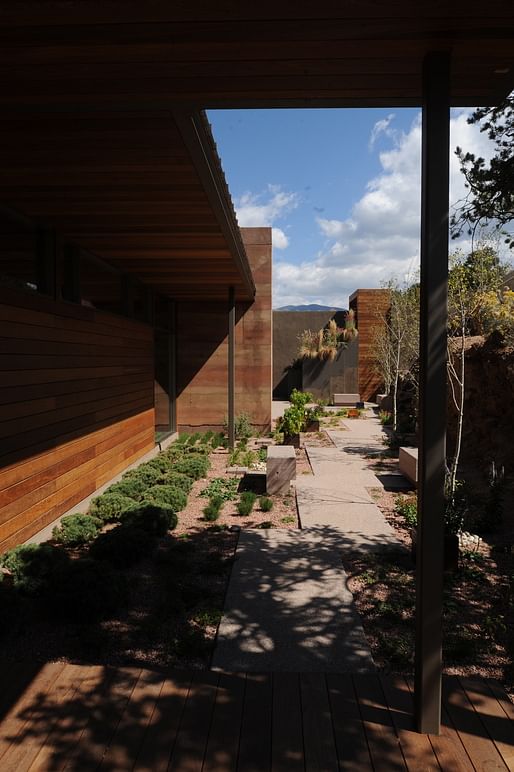

Increasingly, I’m more interested in what architecture does than just what it is. In a previous blog, I wrote about the new office building we designed for Wiss, Janney, Elstner Associates (WJE), in Austin, and the use of thermal mass to control temperature. We’ve now employed those same sustainable principles for a residence in northern New Mexico. The rammed-earth structure, located outside Santa Fe, virtually disappears into its site and surroundings. For the earthen walls, we selected four shades of the indigenous sedimentary dirt to create a deep, luscious palette, and it’s used for both exterior and interior surfaces. In fact, these are much the same colors and hues Georgia O’Keefe found in the same landscape and can often be seen in her paintings. I’m thrilled with how it all turned out, as are the homeowners. The house is invisible from the street and even when approached close up, one must proceed through vegetation and down a broad stair into a courtyard. Only then can one see the entire house.
How all these elements – location, materials, building placement, wall density – work together is the real story here. At 6,200 feet, the local climate is high, arid desert with very warm summertime temperatures and a sharply colder winter. By siting the building to face south, we gained excellent winter solar exposure. Large, ipe wood overhangs and a trellis act as a brise soleil, while the dense walls soak up the daily solar gain and radiate it back at night. The huge, sliding, high-performance glass door openings permit a comfortable, steady cross-ventilation fed by the mountain chaparrals. With the deep sunshades, the house is pretty much clear of the sun’s arc in the summer sky, and yet takes full advantage of the direct light in the cooler months. The result is that both air conditioning and heating requirements are greatly reduced, although systems for each are carefully integrated into the structure and are there as a back up. Sophisticated sensors in the house monitor temperature swings (which, so far, are virtually non-existent). In short, we’ve built a beautiful, self-regulating performance envelope with essentially just dirt.

 Inside, the concrete floors (with embedded radiant heat) were made using local gravel cast into the final mix, and then diamond-finished as one would with terrazzo. As with the walls, the floors have a solid, rich visual quality and their colors are seen not only inside the house but also out in the broader landscape.
Inside, the concrete floors (with embedded radiant heat) were made using local gravel cast into the final mix, and then diamond-finished as one would with terrazzo. As with the walls, the floors have a solid, rich visual quality and their colors are seen not only inside the house but also out in the broader landscape.
In designing the thermal performance of the house we used largely empirical methods. We looked at what had been done elsewhere, how it had been done, and what worked. This method has been used for centuries, long before computers and high-tech calculations. One can see countless similar examples among ancient architecture in Turkey, India, Egypt, and China. We did, of course, consult an engineer for the radiant heat.
Given the excellent monitoring devices built into the house, we will be able to tell how well this house works over various seasons. I am really interested in and committed to the ultimate outcome that we need to measure for a substantial period of time. Might be good for a follow-up blog in the future. I’ll keep you posted.
Although it may sound cliched, I live, eat and breathe architecture. I’m currently a principal in the architectural firm of PageSoutherlandPage and a professor, as well as the former dean, in the School of Architecture at the University of Texas at Austin. My teaching and my blog are aimed at educating people on the importance of great architecture in contemporary American culture.
2 Comments
I was wondering what are those pancakes on the ceiling in the interior shot. There is a lot of visual noise in that ceiling. Looks like lights, supply air and what ever the pancakes are having a war of the worlds.
Not sure of where this project was built...but the first rule of the desert....is it eats wood alive. Maybe the shaded protection will protect it for a while but the life of that wood is limited. I do love the rammed earth, long as you don't get basil erosion...just more thoughts for living in the desert.
Can you talk a little more about basil erosión?im interested on building with rammed earth but Im just learning
Probably metal siding that looks like wood
Basal erosion refers to coving at the base of earthen walls. In non-historic earthen construction, when it occurs it is usually due to improper stormwater management, lack of the code required offset between the earthen wall system and grade, or capillary rise from the foundation. It shouldn't be an issue with any rammed earth building constructed according to the New Mexico Earthen Materials Building Code.
One other thing: the term "sustainable" probably shouldn't be used in conjunction with this project. This looks like portland cement stabilized rammed earth - based on the thickness of the wall it is very likely that there is more portland cement (and thus embodied carbon) in these walls than if it had been constructed out of cast in place concrete.
Block this user
Are you sure you want to block this user and hide all related comments throughout the site?
Archinect
This is your first comment on Archinect. Your comment will be visible once approved.